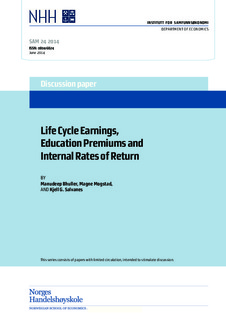Life cycle earnings, education premiums and internal rates of return
Working paper

View/
Date
2014-06Metadata
Show full item recordCollections
- Discussion papers (SAM) [657]
Abstract
What do the education premiums look like over the life cycle? What is the
impact of schooling on lifetime earnings? How does the internal rate of return
compare with opportunity cost of funds? To what extent do progressive taxes
attenuate the incentives to invest in education? This paper exploits Norwegian
population panel data with nearly career long earnings histories to answer these
important questions. We provide a detailed picture of the causal relationship
between schooling and earnings over the life cycle, following individuals over
their working lifespan. To account for endogeneity of schooling, we apply three
commonly used identification strategies. Our estimates show that additional
schooling gives higher lifetime earnings and steeper age-earnings profile, in
line with predictions from human capital theory. These estimates imply an
internal rate of return of around 10 percent, after taking into account income
taxes and earnings-related pension entitlements. Under standard conditions,
this finding suggests it was financially profitable to take additional schooling
because the rates of return were substantially higher than the market interest
rates. By comparison, Mincer regressions understate substantially the rates
of return. We explore the reasons for this downward bias, finding that it is
driven by Mincer’s assumptions of no earnings while in school and exogenous
post-schooling employment.